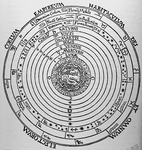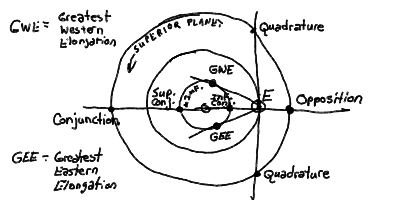 Cosmological Questions --- | ---
Next Lecture - Kepler
Cosmological Questions --- | ---
Next Lecture - Kepler

 Cosmological Questions --- | ---
Next Lecture - Kepler
Cosmological Questions --- | ---
Next Lecture - Kepler


Reading:
Chapter 1-1 (ZG4)
 |
Key Question: | How were the geocentric and heliocentric cosmologies developed? |
|---|---|---|
 |
Key Observation: | Retrograde Motion |
 |
Key Problem: | How do you find the orbital distance of a planet? |
 |
Key Quote: | Hey, the Greeks weren't stupid. |
In class during Lecture 1, I made a brief mention of how I remembered hearing that the Mayans used eclipse cycles in their calanders. Several of you expressed interest in this after class, so I thought I would follow that topic up.
Some information is provided by the "Cambridge Illustrated History of Astronomy", which is a very interesting book in its own right. I have a copy in my office, and I have asked for one to be placed on reserve in the Math-Physics-Astronomy library (3rd floor DRL). The Mayans flourished in what is now southern Mexico, Guatemala, and Belize. They had an extremely tortuous calendar system, and were obsessed with the cycles of the Sun, Venus, and the Moon. One of their cycles corresponds to the "eclipse year" of 173 days (though slightly distorted to shoehorn in with an ubiquitous 260 day almanac). In that description, I saw no mention of the 18.06 year Saros.
As the planets revolve about the Sun in their various orbits, they appear in the sky in different configurations with respect to the Sun. For example, two of the planets, Mercury and Venus, always are found near the Sun --- no more than 47 degrees, in the case of Venus, and no more than about 20 degrees in the case of Mercury. The other naked-eye planets known to early astronomers, Mars, Jupiter and Saturn, can be found anywhere along the ecliptic with respect to the Sun.
The planets with orbits inside of the Earth's orbit, Mercury and Venus, are called inferior planets. The planets with orbits outside the Earth's orbit, Mars, Jupiter, Saturn (and the rest) are called superior planets.
Planets on the opposite side of the ecliptic from the Sun are in opposition, those on the same side are in conjunction. The inferior planets can never be found at opposition, but can be in conjunction on the near side of the Sun (inferior conjunction) or the far side of the Sun (superior conjunction) from the Earth. The superior planets are in conjunction on the far side of the Sun, naturally, and are at closest approach to the Earth during opposition. For superior planets, there are two configurations where the planets is 90 degrees from the Sun. These are known as quadrature.

The elongation of a planet is the angular distance from the Sun of the planet. Elongations range from 0 degrees (conjunction) to 180 degrees (opposition) for superior planets. For inferior planets, the elongations reach a maximum --- the greatest eastern elongation and the greatest western elongation --- from the Sun.
 Prev Lecture ---
Prev Lecture ---
 Next Lecture ---
Next Lecture ---
 Astr11 Index ---
Astr11 Index ---
 Astr11 Home
Astr11 Home
smyers@nrao.edu Steven T. Myers